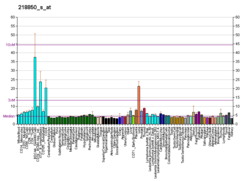LIMD1
LIM domain-containing protein 1 is a protein that in humans is encoded by the LIMD1 gene.[5][6]
References
- 1 2 3 GRCh38: Ensembl release 89: ENSG00000144791 - Ensembl, May 2017
- 1 2 3 GRCm38: Ensembl release 89: ENSMUSG00000025239 - Ensembl, May 2017
- ↑ "Human PubMed Reference:".
- ↑ "Mouse PubMed Reference:".
- ↑ Kiss H, Kedra D, Yang Y, Kost-Alimova M, Kiss C, O'Brien KP, Fransson I, Klein G, Imreh S, Dumanski JP (Feb 2000). "A novel gene containing LIM domains (LIMD1) is located within the common eliminated region 1 (C3CER1) in 3p21.3". Hum Genet. 105 (6): 552–9. doi:10.1007/s004390051144. PMID 10647888.
- ↑ "Entrez Gene: LIMD1 LIM domains containing 1".
Further reading
- Jiang T, Altman S (2001). "Protein-protein interactions with subunits of human nuclear RNase P." Proc. Natl. Acad. Sci. U.S.A. 98 (3): 920–5. doi:10.1073/pnas.021561498. PMC 14685. PMID 11158571.
- Kiss H, Kedra D, Kiss C, et al. (2001). "The LZTFL1 gene is a part of a transcriptional map covering 250 kb within the common eliminated region 1 (C3CER1) in 3p21.3". Genomics. 73 (1): 10–9. doi:10.1006/geno.2000.6498. PMID 11352561.
- Strausberg RL, Feingold EA, Grouse LH, et al. (2003). "Generation and initial analysis of more than 15,000 full-length human and mouse cDNA sequences". Proc. Natl. Acad. Sci. U.S.A. 99 (26): 16899–903. doi:10.1073/pnas.242603899. PMC 139241. PMID 12477932.
- Ota T, Suzuki Y, Nishikawa T, et al. (2004). "Complete sequencing and characterization of 21,243 full-length human cDNAs". Nat. Genet. 36 (1): 40–5. doi:10.1038/ng1285. PMID 14702039.
- Brill LM, Salomon AR, Ficarro SB, et al. (2004). "Robust phosphoproteomic profiling of tyrosine phosphorylation sites from human T cells using immobilized metal affinity chromatography and tandem mass spectrometry". Anal. Chem. 76 (10): 2763–72. doi:10.1021/ac035352d. PMID 15144186.
- Colland F, Jacq X, Trouplin V, et al. (2004). "Functional proteomics mapping of a human signaling pathway". Genome Res. 14 (7): 1324–32. doi:10.1101/gr.2334104. PMC 442148. PMID 15231748.
- Gerhard DS, Wagner L, Feingold EA, et al. (2004). "The status, quality, and expansion of the NIH full-length cDNA project: the Mammalian Gene Collection (MGC)". Genome Res. 14 (10B): 2121–7. doi:10.1101/gr.2596504. PMC 528928. PMID 15489334.
- Sharp TV, Munoz F, Bourboulia D, et al. (2004). "LIM domains-containing protein 1 (LIMD1), a tumor suppressor encoded at chromosome 3p21.3, binds pRB and represses E2F-driven transcription". Proc. Natl. Acad. Sci. U.S.A. 101 (47): 16531–6. doi:10.1073/pnas.0407123101. PMC 534532. PMID 15542589.
- Feng Y, Longmore GD (2005). "The LIM protein Ajuba influences interleukin-1-induced NF-kappaB activation by affecting the assembly and activity of the protein kinase Czeta/p62/TRAF6 signaling complex". Mol. Cell. Biol. 25 (10): 4010–22. doi:10.1128/MCB.25.10.4010-4022.2005. PMC 1087715. PMID 15870274.
- Huggins CJ, Gill M, Andrulis IL (2007). "Identification of rare variants in the hLIMD1 gene in breast cancer". Cancer Genet. Cytogenet. 178 (1): 36–41. doi:10.1016/j.cancergencyto.2007.06.007. PMID 17889706.
This article is issued from
Wikipedia.
The text is licensed under Creative Commons - Attribution - Sharealike.
Additional terms may apply for the media files.




